Laboratory Experiment On Viscosity Of Oil
VerifiedAdded on 2022/08/15
|11
|1423
|36
AI Summary
Contribute Materials
Your contribution can guide someone’s learning journey. Share your
documents today.
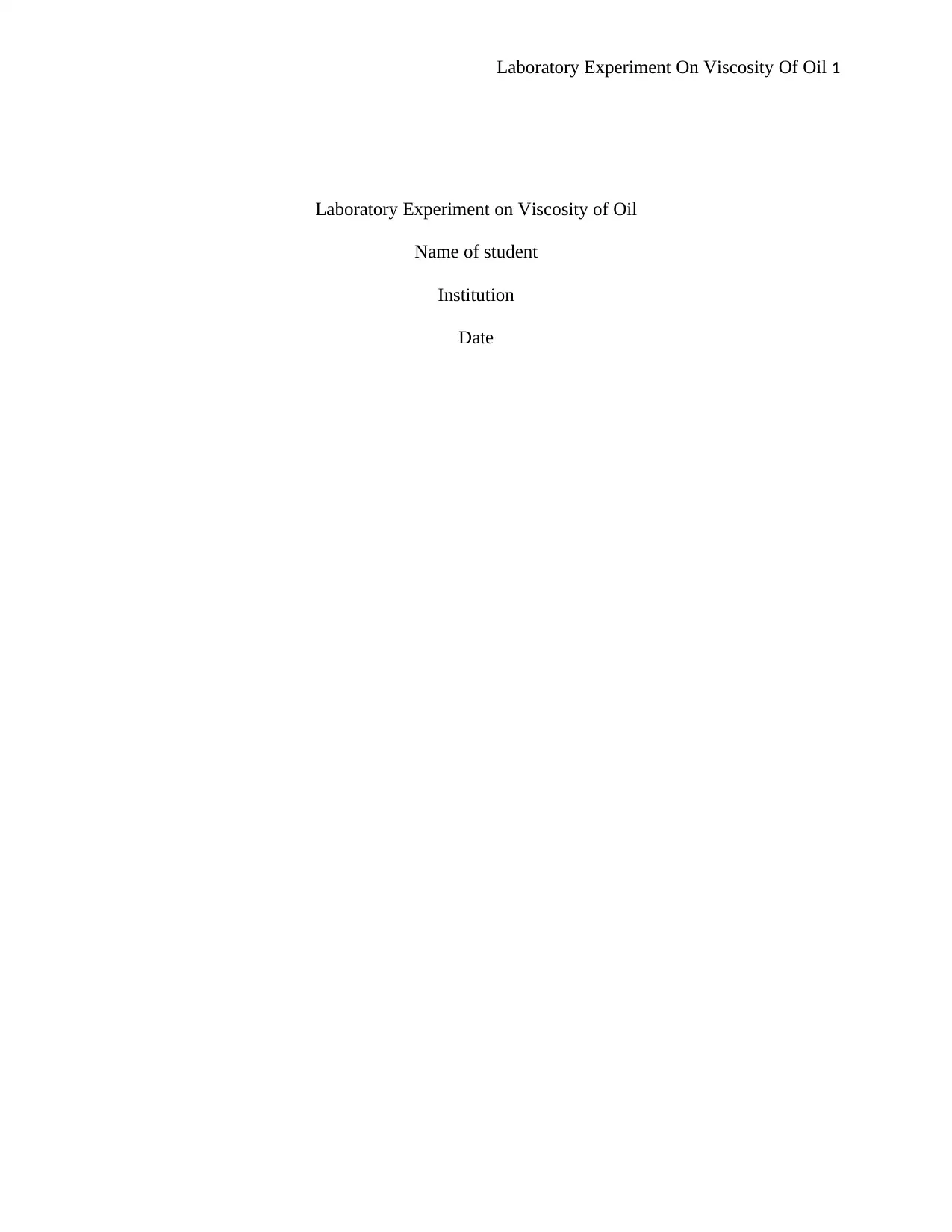
Laboratory Experiment On Viscosity Of Oil 1
Laboratory Experiment on Viscosity of Oil
Name of student
Institution
Date
Laboratory Experiment on Viscosity of Oil
Name of student
Institution
Date
Secure Best Marks with AI Grader
Need help grading? Try our AI Grader for instant feedback on your assignments.
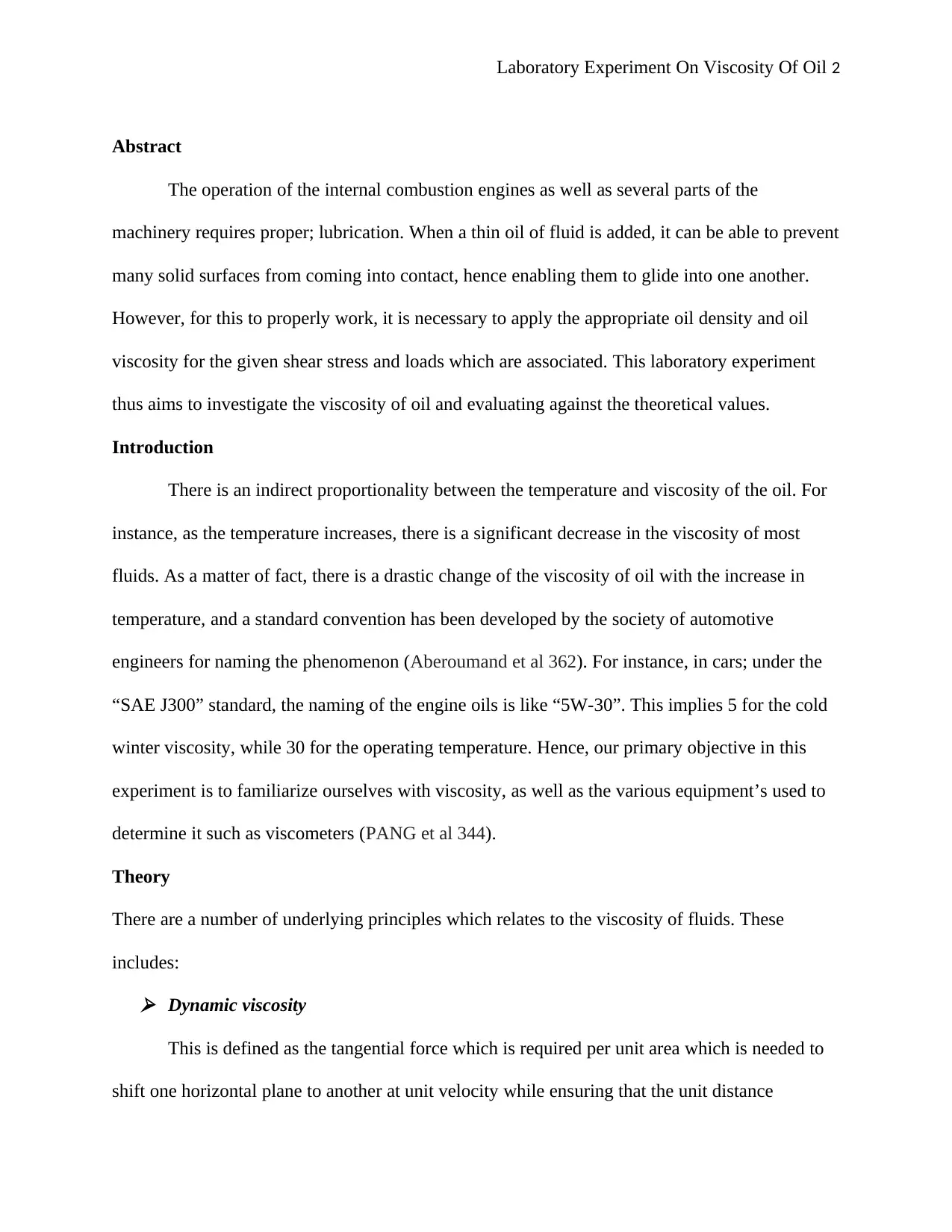
Laboratory Experiment On Viscosity Of Oil 2
Abstract
The operation of the internal combustion engines as well as several parts of the
machinery requires proper; lubrication. When a thin oil of fluid is added, it can be able to prevent
many solid surfaces from coming into contact, hence enabling them to glide into one another.
However, for this to properly work, it is necessary to apply the appropriate oil density and oil
viscosity for the given shear stress and loads which are associated. This laboratory experiment
thus aims to investigate the viscosity of oil and evaluating against the theoretical values.
Introduction
There is an indirect proportionality between the temperature and viscosity of the oil. For
instance, as the temperature increases, there is a significant decrease in the viscosity of most
fluids. As a matter of fact, there is a drastic change of the viscosity of oil with the increase in
temperature, and a standard convention has been developed by the society of automotive
engineers for naming the phenomenon (Aberoumand et al 362). For instance, in cars; under the
“SAE J300” standard, the naming of the engine oils is like “5W-30”. This implies 5 for the cold
winter viscosity, while 30 for the operating temperature. Hence, our primary objective in this
experiment is to familiarize ourselves with viscosity, as well as the various equipment’s used to
determine it such as viscometers (PANG et al 344).
Theory
There are a number of underlying principles which relates to the viscosity of fluids. These
includes: Dynamic viscosity
This is defined as the tangential force which is required per unit area which is needed to
shift one horizontal plane to another at unit velocity while ensuring that the unit distance
Abstract
The operation of the internal combustion engines as well as several parts of the
machinery requires proper; lubrication. When a thin oil of fluid is added, it can be able to prevent
many solid surfaces from coming into contact, hence enabling them to glide into one another.
However, for this to properly work, it is necessary to apply the appropriate oil density and oil
viscosity for the given shear stress and loads which are associated. This laboratory experiment
thus aims to investigate the viscosity of oil and evaluating against the theoretical values.
Introduction
There is an indirect proportionality between the temperature and viscosity of the oil. For
instance, as the temperature increases, there is a significant decrease in the viscosity of most
fluids. As a matter of fact, there is a drastic change of the viscosity of oil with the increase in
temperature, and a standard convention has been developed by the society of automotive
engineers for naming the phenomenon (Aberoumand et al 362). For instance, in cars; under the
“SAE J300” standard, the naming of the engine oils is like “5W-30”. This implies 5 for the cold
winter viscosity, while 30 for the operating temperature. Hence, our primary objective in this
experiment is to familiarize ourselves with viscosity, as well as the various equipment’s used to
determine it such as viscometers (PANG et al 344).
Theory
There are a number of underlying principles which relates to the viscosity of fluids. These
includes: Dynamic viscosity
This is defined as the tangential force which is required per unit area which is needed to
shift one horizontal plane to another at unit velocity while ensuring that the unit distance
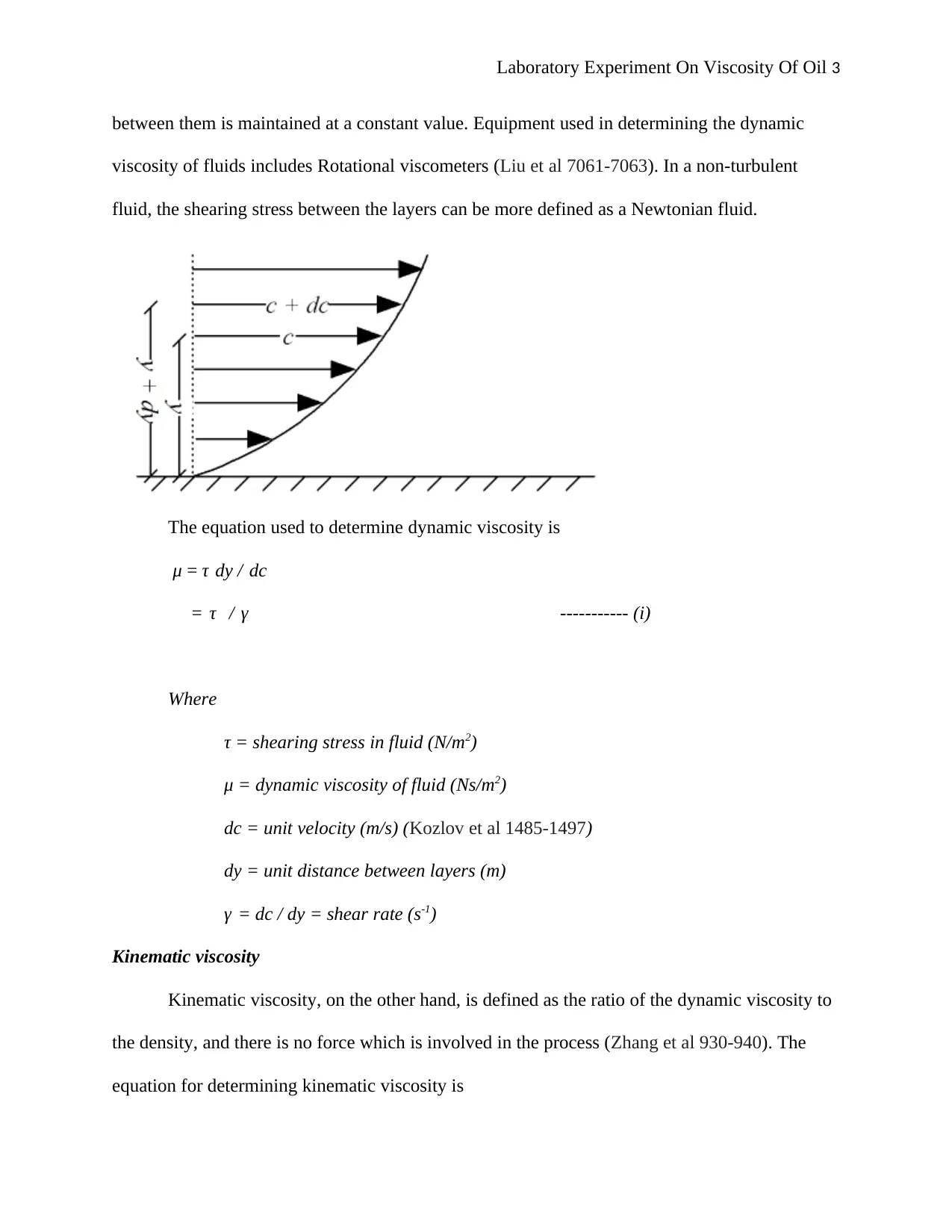
Laboratory Experiment On Viscosity Of Oil 3
between them is maintained at a constant value. Equipment used in determining the dynamic
viscosity of fluids includes Rotational viscometers (Liu et al 7061-7063). In a non-turbulent
fluid, the shearing stress between the layers can be more defined as a Newtonian fluid.
The equation used to determine dynamic viscosity is
μ = τ dy / dc
= τ / γ ----------- (i)
Where
τ = shearing stress in fluid (N/m2)
μ = dynamic viscosity of fluid (Ns/m2)
dc = unit velocity (m/s) (Kozlov et al 1485-1497)
dy = unit distance between layers (m)
γ = dc / dy = shear rate (s-1)
Kinematic viscosity
Kinematic viscosity, on the other hand, is defined as the ratio of the dynamic viscosity to
the density, and there is no force which is involved in the process (Zhang et al 930-940). The
equation for determining kinematic viscosity is
between them is maintained at a constant value. Equipment used in determining the dynamic
viscosity of fluids includes Rotational viscometers (Liu et al 7061-7063). In a non-turbulent
fluid, the shearing stress between the layers can be more defined as a Newtonian fluid.
The equation used to determine dynamic viscosity is
μ = τ dy / dc
= τ / γ ----------- (i)
Where
τ = shearing stress in fluid (N/m2)
μ = dynamic viscosity of fluid (Ns/m2)
dc = unit velocity (m/s) (Kozlov et al 1485-1497)
dy = unit distance between layers (m)
γ = dc / dy = shear rate (s-1)
Kinematic viscosity
Kinematic viscosity, on the other hand, is defined as the ratio of the dynamic viscosity to
the density, and there is no force which is involved in the process (Zhang et al 930-940). The
equation for determining kinematic viscosity is
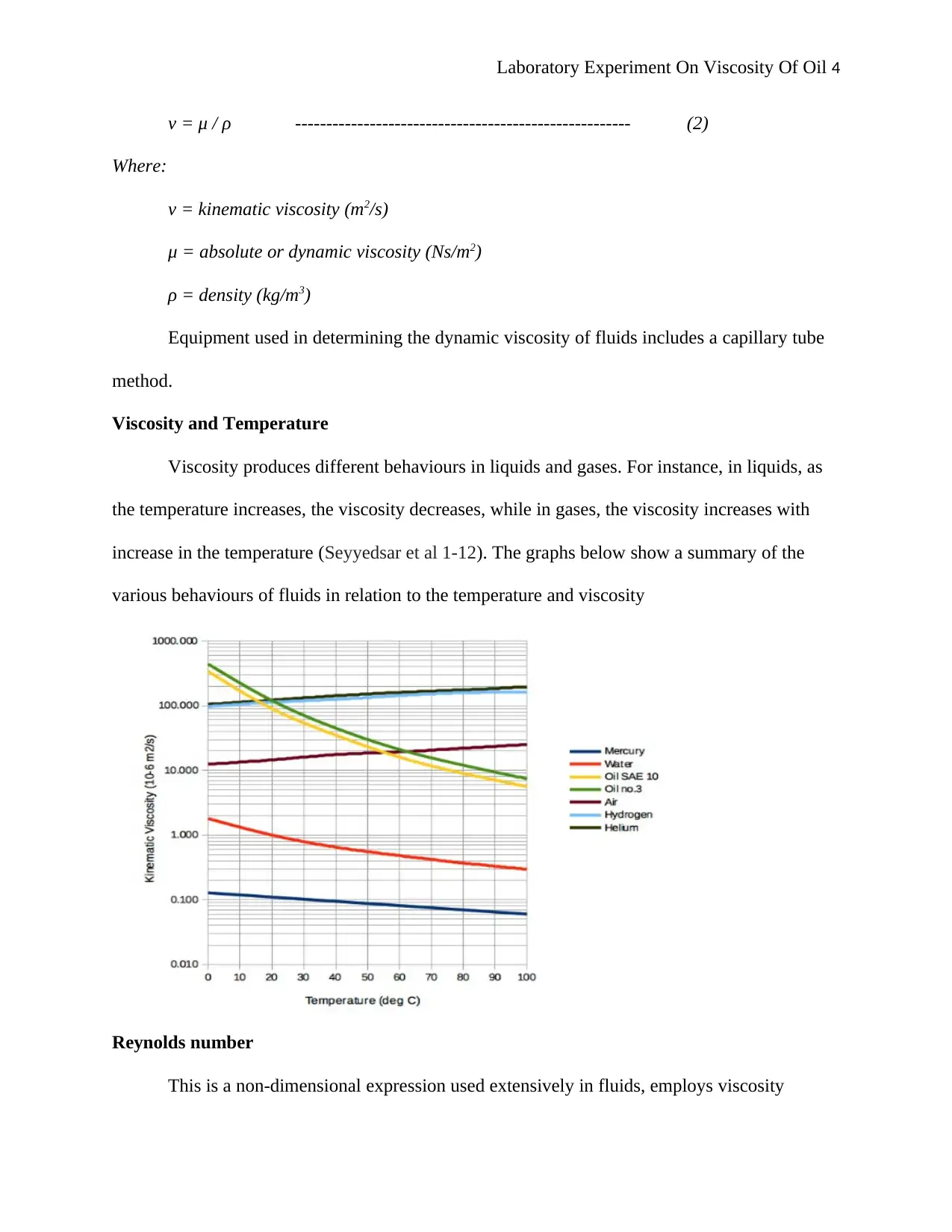
Laboratory Experiment On Viscosity Of Oil 4
ν = μ / ρ ------------------------------------------------------ (2)
Where:
ν = kinematic viscosity (m2/s)
μ = absolute or dynamic viscosity (Ns/m2)
ρ = density (kg/m3)
Equipment used in determining the dynamic viscosity of fluids includes a capillary tube
method.
Viscosity and Temperature
Viscosity produces different behaviours in liquids and gases. For instance, in liquids, as
the temperature increases, the viscosity decreases, while in gases, the viscosity increases with
increase in the temperature (Seyyedsar et al 1-12). The graphs below show a summary of the
various behaviours of fluids in relation to the temperature and viscosity
Reynolds number
This is a non-dimensional expression used extensively in fluids, employs viscosity
ν = μ / ρ ------------------------------------------------------ (2)
Where:
ν = kinematic viscosity (m2/s)
μ = absolute or dynamic viscosity (Ns/m2)
ρ = density (kg/m3)
Equipment used in determining the dynamic viscosity of fluids includes a capillary tube
method.
Viscosity and Temperature
Viscosity produces different behaviours in liquids and gases. For instance, in liquids, as
the temperature increases, the viscosity decreases, while in gases, the viscosity increases with
increase in the temperature (Seyyedsar et al 1-12). The graphs below show a summary of the
various behaviours of fluids in relation to the temperature and viscosity
Reynolds number
This is a non-dimensional expression used extensively in fluids, employs viscosity
Secure Best Marks with AI Grader
Need help grading? Try our AI Grader for instant feedback on your assignments.
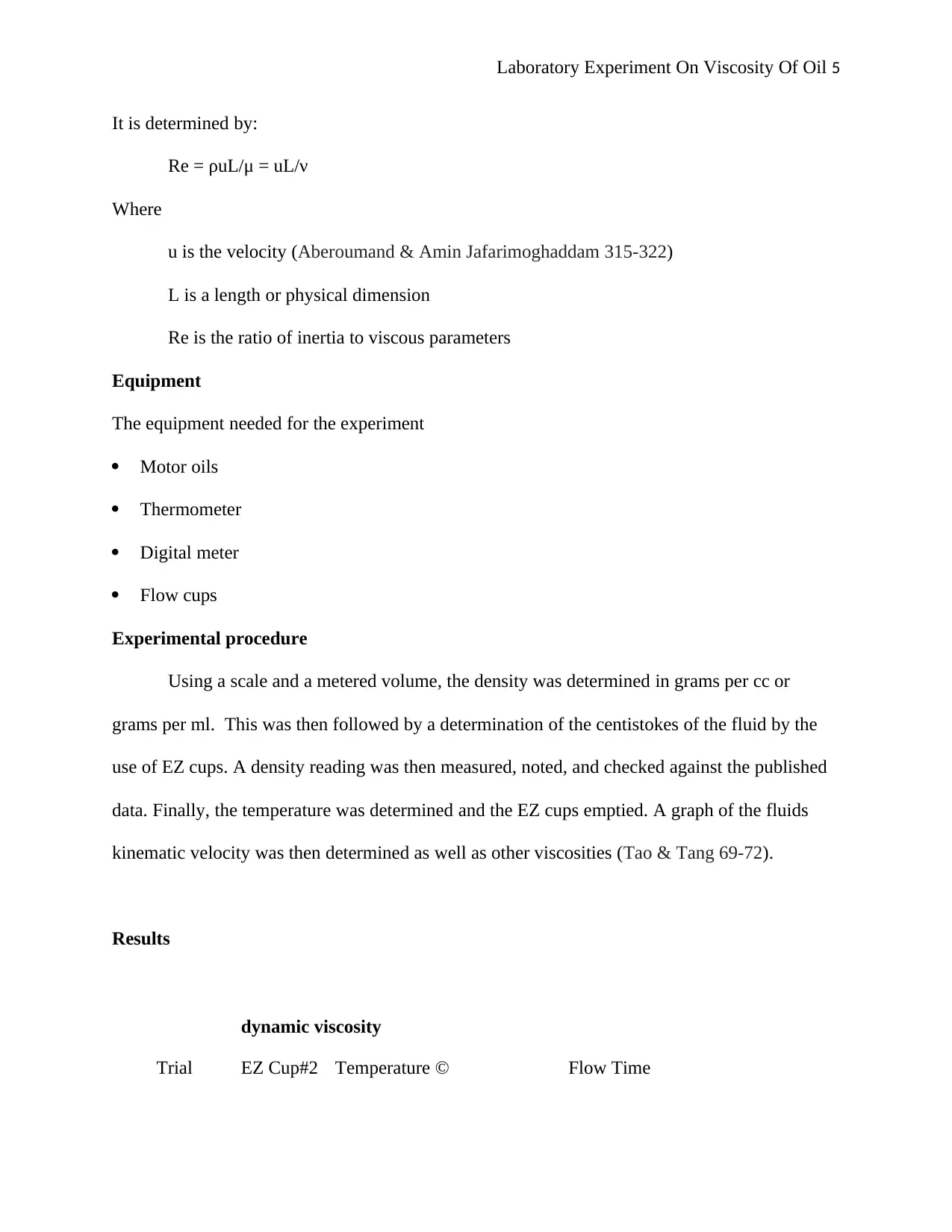
Laboratory Experiment On Viscosity Of Oil 5
It is determined by:
Re = ρuL/μ = uL/ν
Where
u is the velocity (Aberoumand & Amin Jafarimoghaddam 315-322)
L is a length or physical dimension
Re is the ratio of inertia to viscous parameters
Equipment
The equipment needed for the experiment
Motor oils
Thermometer
Digital meter
Flow cups
Experimental procedure
Using a scale and a metered volume, the density was determined in grams per cc or
grams per ml. This was then followed by a determination of the centistokes of the fluid by the
use of EZ cups. A density reading was then measured, noted, and checked against the published
data. Finally, the temperature was determined and the EZ cups emptied. A graph of the fluids
kinematic velocity was then determined as well as other viscosities (Tao & Tang 69-72).
Results
dynamic viscosity
Trial EZ Cup#2 Temperature © Flow Time
It is determined by:
Re = ρuL/μ = uL/ν
Where
u is the velocity (Aberoumand & Amin Jafarimoghaddam 315-322)
L is a length or physical dimension
Re is the ratio of inertia to viscous parameters
Equipment
The equipment needed for the experiment
Motor oils
Thermometer
Digital meter
Flow cups
Experimental procedure
Using a scale and a metered volume, the density was determined in grams per cc or
grams per ml. This was then followed by a determination of the centistokes of the fluid by the
use of EZ cups. A density reading was then measured, noted, and checked against the published
data. Finally, the temperature was determined and the EZ cups emptied. A graph of the fluids
kinematic velocity was then determined as well as other viscosities (Tao & Tang 69-72).
Results
dynamic viscosity
Trial EZ Cup#2 Temperature © Flow Time
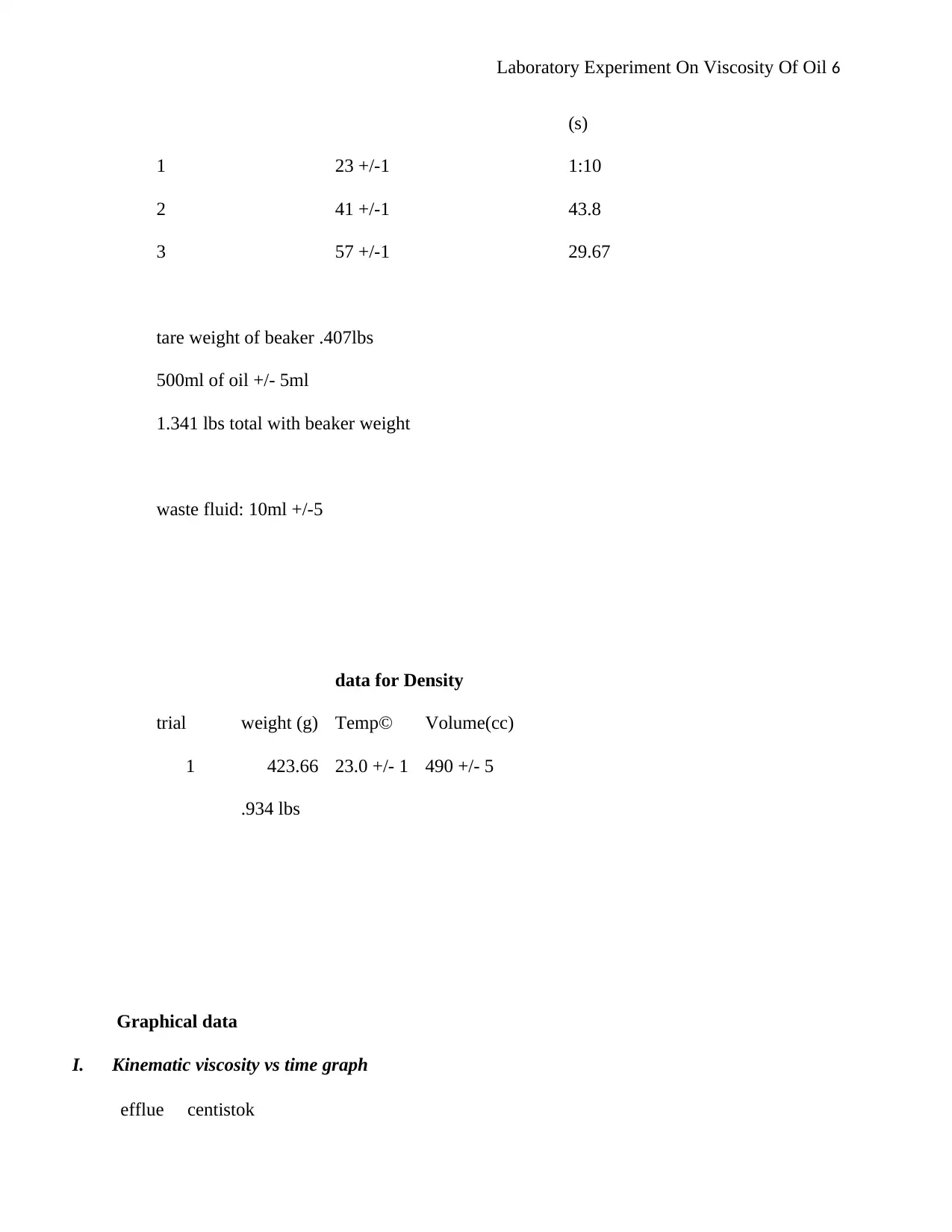
Laboratory Experiment On Viscosity Of Oil 6
(s)
1 23 +/-1 1:10
2 41 +/-1 43.8
3 57 +/-1 29.67
tare weight of beaker .407lbs
500ml of oil +/- 5ml
1.341 lbs total with beaker weight
waste fluid: 10ml +/-5
data for Density
trial weight (g) Temp© Volume(cc)
1 423.66 23.0 +/- 1 490 +/- 5
.934 lbs
Graphical data
I. Kinematic viscosity vs time graph
efflue centistok
(s)
1 23 +/-1 1:10
2 41 +/-1 43.8
3 57 +/-1 29.67
tare weight of beaker .407lbs
500ml of oil +/- 5ml
1.341 lbs total with beaker weight
waste fluid: 10ml +/-5
data for Density
trial weight (g) Temp© Volume(cc)
1 423.66 23.0 +/- 1 490 +/- 5
.934 lbs
Graphical data
I. Kinematic viscosity vs time graph
efflue centistok
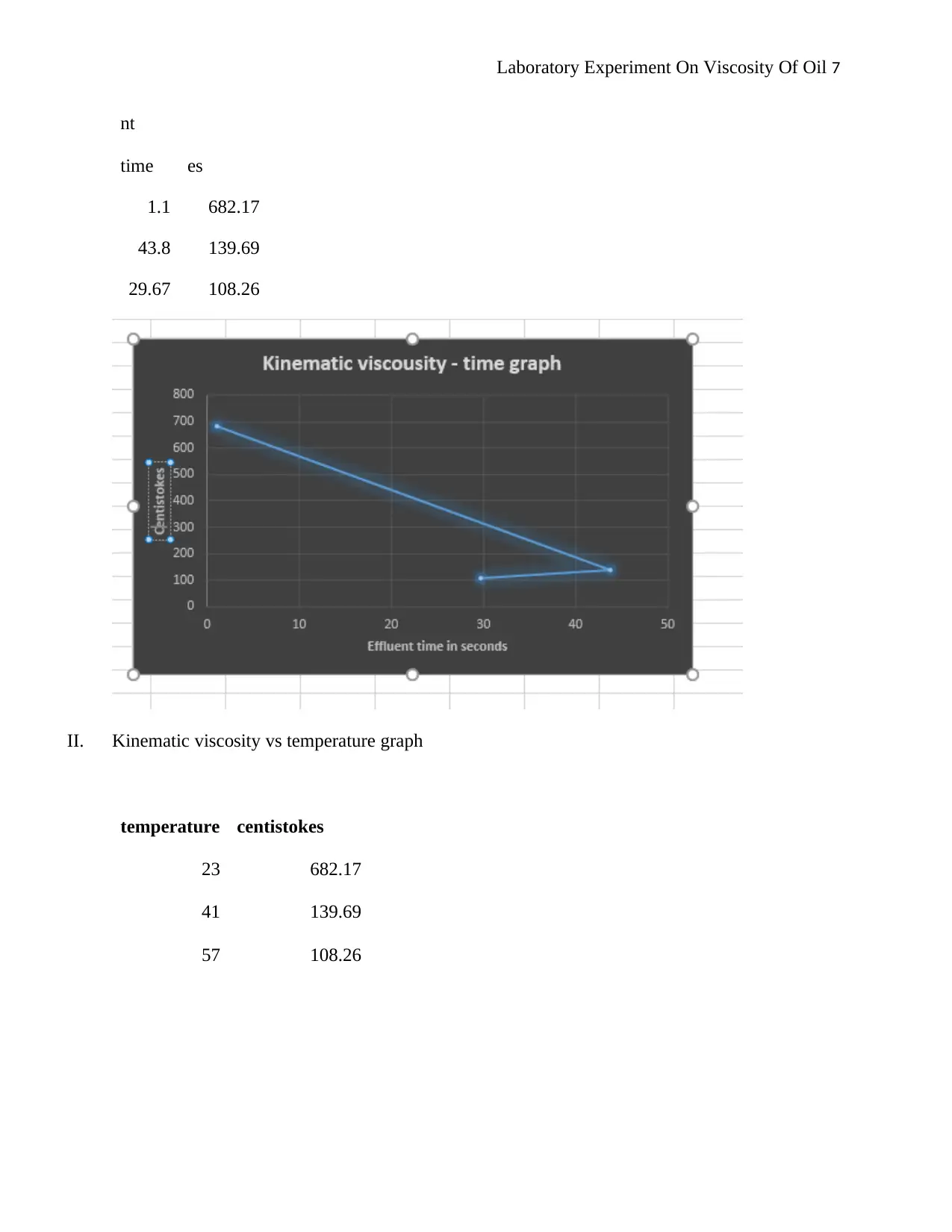
Laboratory Experiment On Viscosity Of Oil 7
nt
time es
1.1 682.17
43.8 139.69
29.67 108.26
II. Kinematic viscosity vs temperature graph
temperature centistokes
23 682.17
41 139.69
57 108.26
nt
time es
1.1 682.17
43.8 139.69
29.67 108.26
II. Kinematic viscosity vs temperature graph
temperature centistokes
23 682.17
41 139.69
57 108.26
Paraphrase This Document
Need a fresh take? Get an instant paraphrase of this document with our AI Paraphraser
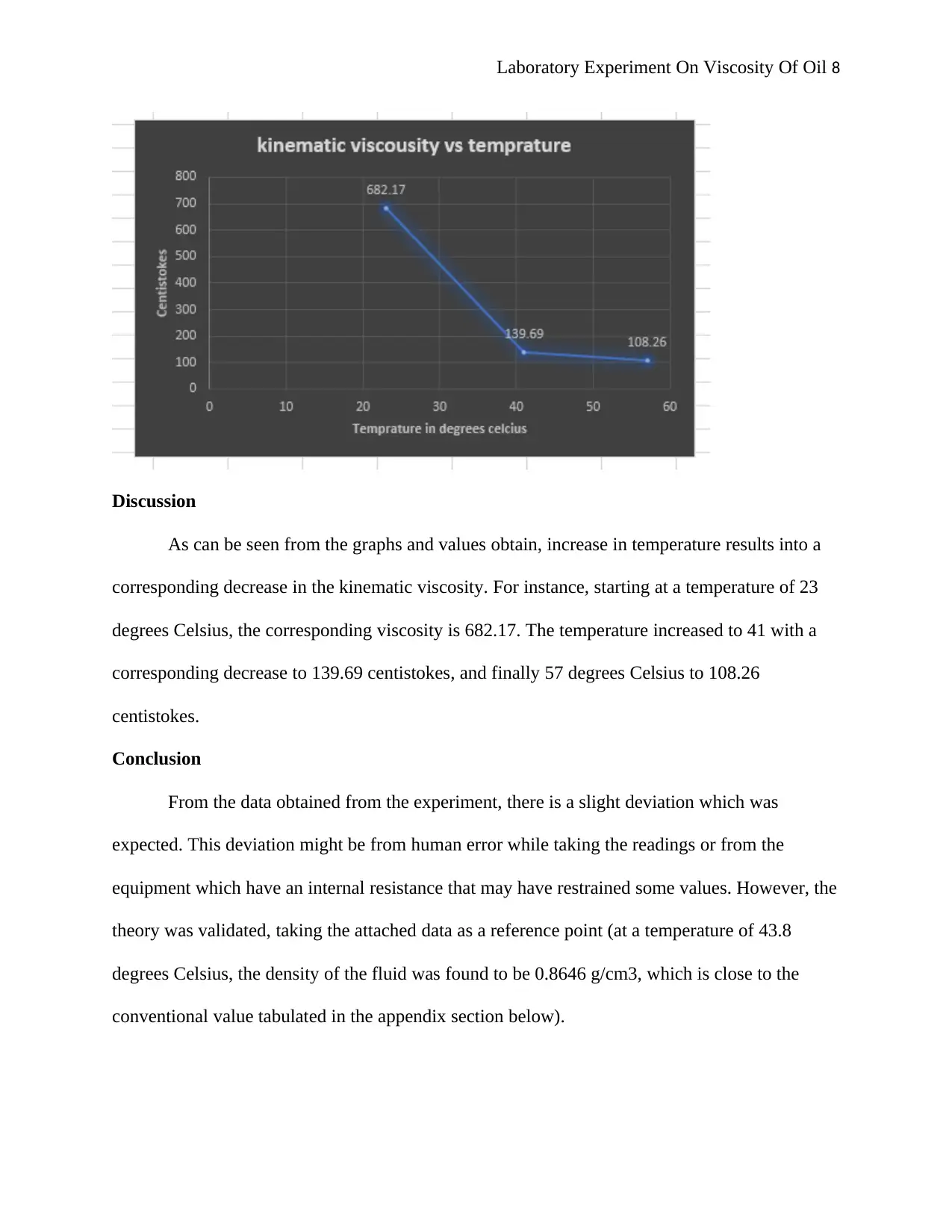
Laboratory Experiment On Viscosity Of Oil 8
Discussion
As can be seen from the graphs and values obtain, increase in temperature results into a
corresponding decrease in the kinematic viscosity. For instance, starting at a temperature of 23
degrees Celsius, the corresponding viscosity is 682.17. The temperature increased to 41 with a
corresponding decrease to 139.69 centistokes, and finally 57 degrees Celsius to 108.26
centistokes.
Conclusion
From the data obtained from the experiment, there is a slight deviation which was
expected. This deviation might be from human error while taking the readings or from the
equipment which have an internal resistance that may have restrained some values. However, the
theory was validated, taking the attached data as a reference point (at a temperature of 43.8
degrees Celsius, the density of the fluid was found to be 0.8646 g/cm3, which is close to the
conventional value tabulated in the appendix section below).
Discussion
As can be seen from the graphs and values obtain, increase in temperature results into a
corresponding decrease in the kinematic viscosity. For instance, starting at a temperature of 23
degrees Celsius, the corresponding viscosity is 682.17. The temperature increased to 41 with a
corresponding decrease to 139.69 centistokes, and finally 57 degrees Celsius to 108.26
centistokes.
Conclusion
From the data obtained from the experiment, there is a slight deviation which was
expected. This deviation might be from human error while taking the readings or from the
equipment which have an internal resistance that may have restrained some values. However, the
theory was validated, taking the attached data as a reference point (at a temperature of 43.8
degrees Celsius, the density of the fluid was found to be 0.8646 g/cm3, which is close to the
conventional value tabulated in the appendix section below).
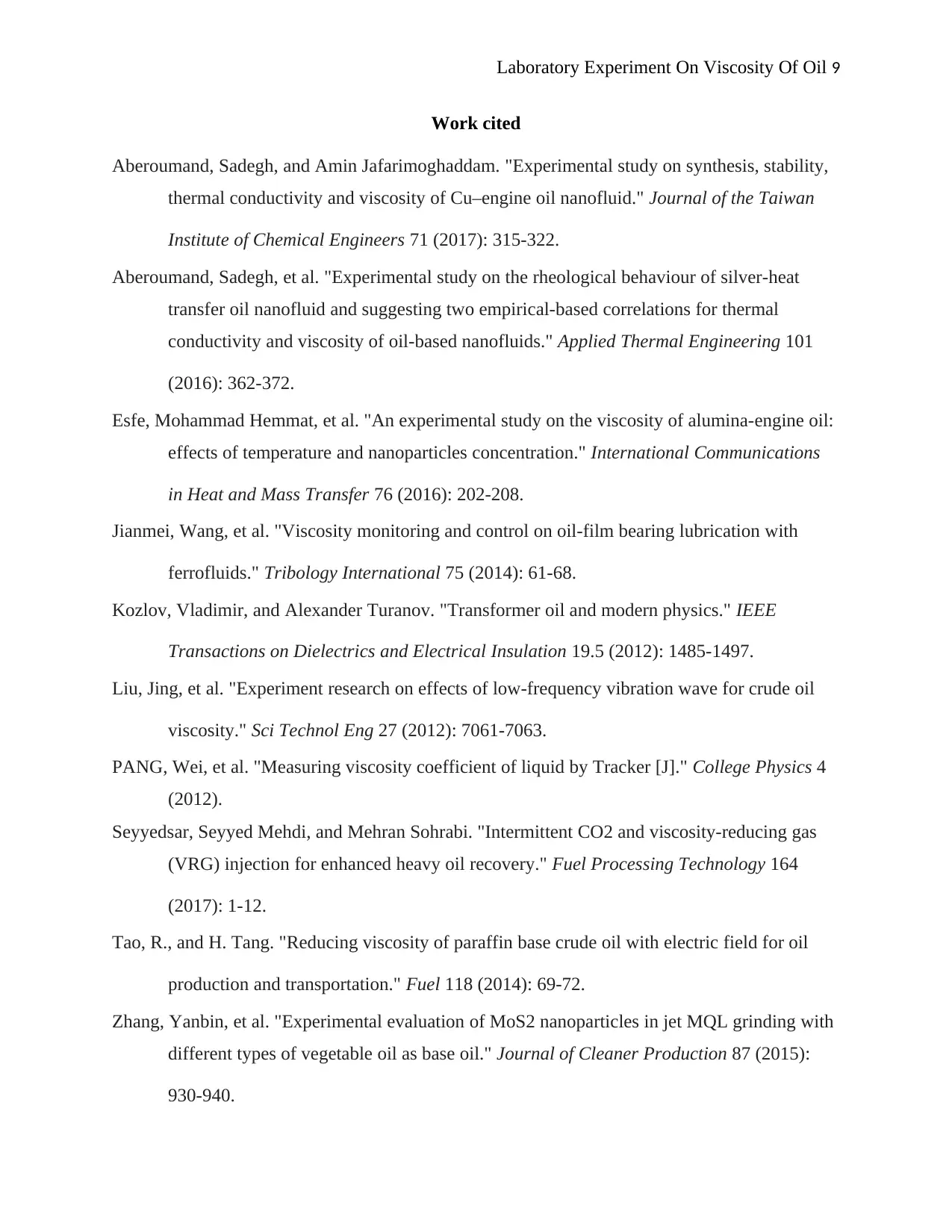
Laboratory Experiment On Viscosity Of Oil 9
Work cited
Aberoumand, Sadegh, and Amin Jafarimoghaddam. "Experimental study on synthesis, stability,
thermal conductivity and viscosity of Cu–engine oil nanofluid." Journal of the Taiwan
Institute of Chemical Engineers 71 (2017): 315-322.
Aberoumand, Sadegh, et al. "Experimental study on the rheological behaviour of silver-heat
transfer oil nanofluid and suggesting two empirical-based correlations for thermal
conductivity and viscosity of oil-based nanofluids." Applied Thermal Engineering 101
(2016): 362-372.
Esfe, Mohammad Hemmat, et al. "An experimental study on the viscosity of alumina-engine oil:
effects of temperature and nanoparticles concentration." International Communications
in Heat and Mass Transfer 76 (2016): 202-208.
Jianmei, Wang, et al. "Viscosity monitoring and control on oil-film bearing lubrication with
ferrofluids." Tribology International 75 (2014): 61-68.
Kozlov, Vladimir, and Alexander Turanov. "Transformer oil and modern physics." IEEE
Transactions on Dielectrics and Electrical Insulation 19.5 (2012): 1485-1497.
Liu, Jing, et al. "Experiment research on effects of low-frequency vibration wave for crude oil
viscosity." Sci Technol Eng 27 (2012): 7061-7063.
PANG, Wei, et al. "Measuring viscosity coefficient of liquid by Tracker [J]." College Physics 4
(2012).
Seyyedsar, Seyyed Mehdi, and Mehran Sohrabi. "Intermittent CO2 and viscosity-reducing gas
(VRG) injection for enhanced heavy oil recovery." Fuel Processing Technology 164
(2017): 1-12.
Tao, R., and H. Tang. "Reducing viscosity of paraffin base crude oil with electric field for oil
production and transportation." Fuel 118 (2014): 69-72.
Zhang, Yanbin, et al. "Experimental evaluation of MoS2 nanoparticles in jet MQL grinding with
different types of vegetable oil as base oil." Journal of Cleaner Production 87 (2015):
930-940.
Work cited
Aberoumand, Sadegh, and Amin Jafarimoghaddam. "Experimental study on synthesis, stability,
thermal conductivity and viscosity of Cu–engine oil nanofluid." Journal of the Taiwan
Institute of Chemical Engineers 71 (2017): 315-322.
Aberoumand, Sadegh, et al. "Experimental study on the rheological behaviour of silver-heat
transfer oil nanofluid and suggesting two empirical-based correlations for thermal
conductivity and viscosity of oil-based nanofluids." Applied Thermal Engineering 101
(2016): 362-372.
Esfe, Mohammad Hemmat, et al. "An experimental study on the viscosity of alumina-engine oil:
effects of temperature and nanoparticles concentration." International Communications
in Heat and Mass Transfer 76 (2016): 202-208.
Jianmei, Wang, et al. "Viscosity monitoring and control on oil-film bearing lubrication with
ferrofluids." Tribology International 75 (2014): 61-68.
Kozlov, Vladimir, and Alexander Turanov. "Transformer oil and modern physics." IEEE
Transactions on Dielectrics and Electrical Insulation 19.5 (2012): 1485-1497.
Liu, Jing, et al. "Experiment research on effects of low-frequency vibration wave for crude oil
viscosity." Sci Technol Eng 27 (2012): 7061-7063.
PANG, Wei, et al. "Measuring viscosity coefficient of liquid by Tracker [J]." College Physics 4
(2012).
Seyyedsar, Seyyed Mehdi, and Mehran Sohrabi. "Intermittent CO2 and viscosity-reducing gas
(VRG) injection for enhanced heavy oil recovery." Fuel Processing Technology 164
(2017): 1-12.
Tao, R., and H. Tang. "Reducing viscosity of paraffin base crude oil with electric field for oil
production and transportation." Fuel 118 (2014): 69-72.
Zhang, Yanbin, et al. "Experimental evaluation of MoS2 nanoparticles in jet MQL grinding with
different types of vegetable oil as base oil." Journal of Cleaner Production 87 (2015):
930-940.

Laboratory Experiment On Viscosity Of Oil 10
Secure Best Marks with AI Grader
Need help grading? Try our AI Grader for instant feedback on your assignments.
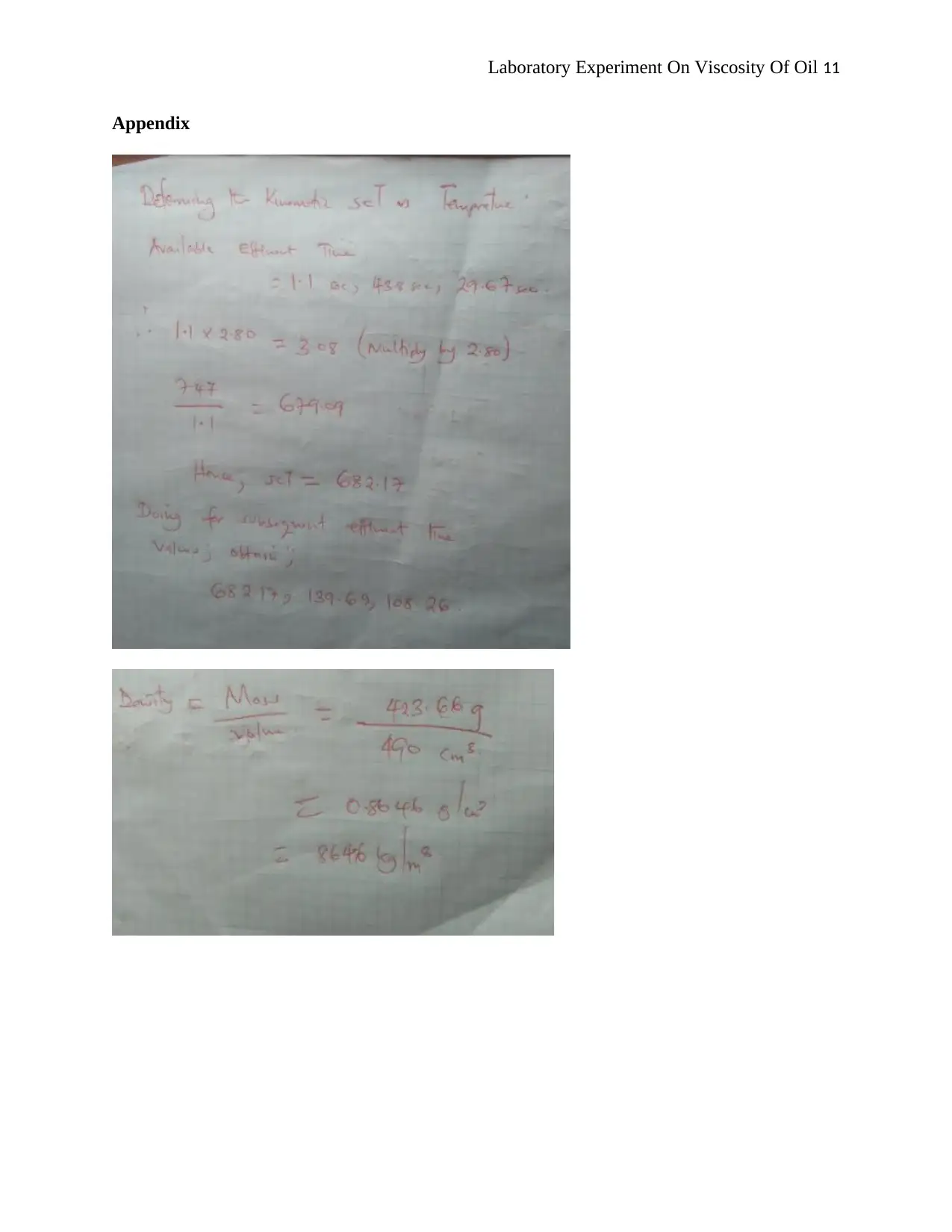
Laboratory Experiment On Viscosity Of Oil 11
Appendix
Appendix
1 out of 11
Your All-in-One AI-Powered Toolkit for Academic Success.
+13062052269
info@desklib.com
Available 24*7 on WhatsApp / Email
![[object Object]](/_next/static/media/star-bottom.7253800d.svg)
Unlock your academic potential
© 2024 | Zucol Services PVT LTD | All rights reserved.